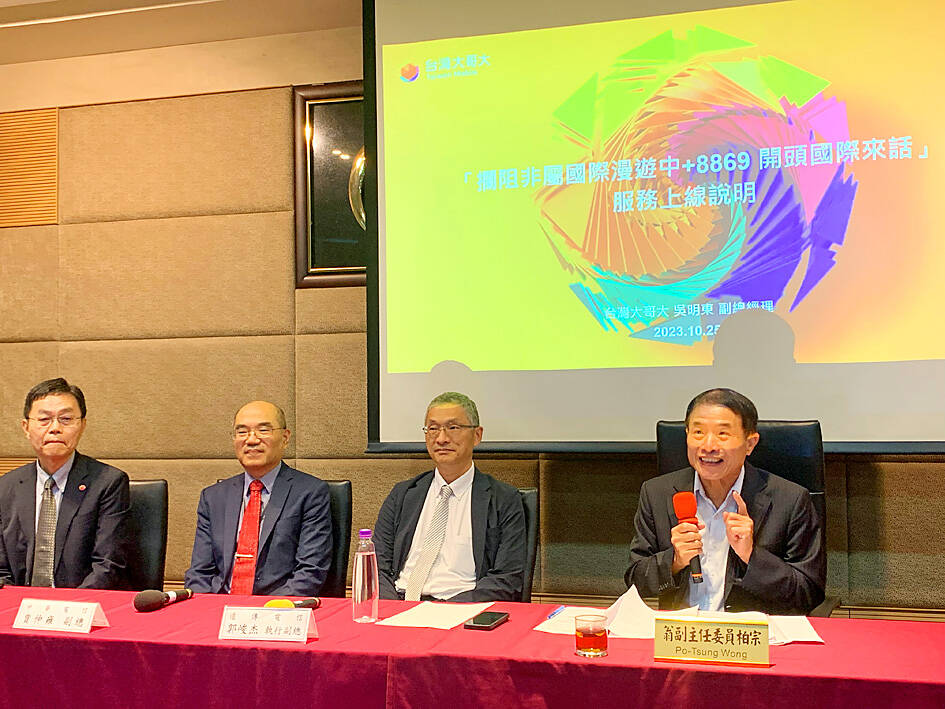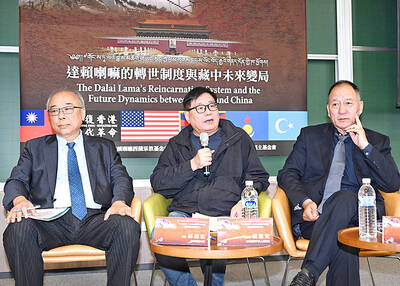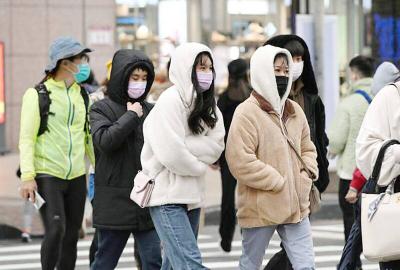The National Communications Commission (NCC) yesterday said it aims to block all calls from overseas using fake Taiwanese telephone numbers and play a scam warning whenever people receive international calls on landlines or mobile phones.
The telecom service regulator made the announcement after a series of anti-fraud initiatives it launched succeeded in filtering a majority of scam calls.
The commission on May 3 began asking telecoms to filter phone calls from +886 0 to +886 8 numbers on landlines and mobile phones.

Photo: Ting Yi, Taipei Times
This month, telecoms started blocking calls from numbers beginning with +886 9 for mobile phone users.
Since July 17, landline users have heard a scam warning when they receive calls from numbers beginning with +886 9, and since Sept. 15 they have heard the same warning when they receive international calls, regardless of the number.
In the second half of last month, telecoms began broadcasting scam warnings for mobile phone users for calls from numbers beginning with +886 9, the commission said.
However, they have not yet succeeded in blocking potential scam calls on landlines from +886 9 numbers, nor have they begun broadcasting warnings for mobile users when they receive international calls, the commission said.
The nation’s three major telecoms — Chunghwa Telecom, Taiwan Mobile and Far EasTone Telecommunications (FET) — were invited by the commission to present a report on the filtering of international calls.
Wu Ming-tung (吳明東), vice president of network and system architecture at Taiwan Mobile, said that the telecom blocked 76 percent of mobile phone calls from numbers beginning with +886 9 from Oct. 13 to Sunday last week.
Chia Chung-yung (賈仲雍), vice president of Chunghwa Telecom’s network technology group, said that the company had witnessed a 68 percent decrease in calls from numbers beginning with +886 9 on its mobile phone services from Sept. 15 and a 98.5 percent decrease on landlines from July 17.
About 50 percent of numbers beginning with +886 9 are blocked on mobile phones daily, Chia said.
Jason Kuo (郭峻杰), vice president of FET’s Network Technologies and Operations Division, said that the telecom has used artificial intelligence to help block scam calls.
On average, it has blocked 97,400 scam calls per month, 194,000 scam messages and 2,540 suspicious Web sites, he said.
NCC statistics showed that the number of international phone calls had fallen from 41.83 million in July to 24.13 million last month, while the percentage of phone calls from numbers beginning with +886 had dropped from an average of 36.1 percent during the first six months of this year, to 7.14 percent last month.
“Thanks to collaborative efforts between the government and telecoms, we can filter scam calls and non-scam calls from numbers beginning with +886 9 and block scam calls. From a technical perspective, this is a great leap forward,” NCC Vice Chairman Wong Po-tsung (翁柏宗) said.
If scammers use a Taiwan Mobile phone number to call a Chunghwa Telecom customer by first rerouting the call through another country, Chunghwa can check with Taiwan Mobile whether the user is actually using its roaming service in another country, Wong said, adding that Chunghwa Telecom can then block the call if the caller is not overseas.
Taiwan is the first country to curb telephone fraud by blocking calls and giving warnings, Wong said, adding that the commission has two other objectives to accomplish.
“First, we aim to comprehensively block calls from overseas that are using fake Taiwanese phone numbers. Second, scam warnings would be available for all international phone calls, both on landlines and mobile phones. If we can reach these two objectives, it would be almost impossible for scammers to commit fraud over the phone,” Wong said.
Previous initiatives were funded through the Executive Yuan’s second preparatory fund, which allocated NT$135 million (US$4.17 million) to the commission, Wong said, adding that the three telecoms matched the fund by jointly providing NT$135 million.
“We will brief the Executive Yuan’s anti-fraud task force about our new plan, which is technically feasible. However, we need additional funding to procure equipment and adjust the system. We hope the Executive Yuan will support us and make the service available as quickly as possible,” he said.

ALIGNED THINKING: Taiwan and Japan have a mutual interest in trade, culture and engineering, and can work together for stability, Cho Jung-tai said Taiwan and Japan are two like-minded countries willing to work together to form a “safety barrier” in the Indo-Pacific region, Premier Cho Jung-tai (卓榮泰) yesterday said at the opening ceremony of the 35th Taiwan-Japan Modern Engineering and Technology Symposium in Taipei. Taiwan and Japan are close geographically and closer emotionally, he added. Citing the overflowing of a barrier lake in the Mataian River (馬太鞍溪) in September, Cho said the submersible water level sensors given by Japan during the disaster helped Taiwan monitor the lake’s water levels more accurately. Japan also provided a lot of vaccines early in the outbreak of the COVID-19 pandemic,

Kaohsiung Mayor Chen Chi-mai (陳其邁) on Monday announced light shows and themed traffic lights to welcome fans of South Korean pop group Twice to the port city. The group is to play Kaohsiung on Saturday as part of its “This Is For” world tour. It would be the group’s first performance in Taiwan since its debut 10 years ago. The all-female group consists of five South Koreans, three Japanese and Tainan’s Chou Tzu-yu (周子瑜), the first Taiwan-born and raised member of a South Korean girl group. To promote the group’s arrival, the city has been holding a series of events, including a pop-up

TEMPORAL/SPIRITUAL: Beijing’s claim that the next Buddhist leader must come from China is a heavy-handed political maneuver that will fall flat-faced, experts said China’s requirement that the Dalai Lama’s reincarnation to be born in China and approved by Beijing has drawn criticism, with experts at a forum in Taipei yesterday saying that if Beijing were to put forth its own Dalai Lama, the person would not be recognized by the Tibetan Buddhist community. The experts made a remarks at the two-day forum hosted by the Tibet Religious Foundation of His Holiness the Dalai Lama titled: “The Snow Land Forum: Finding Common Ground on Tibet.” China says it has the right to determine the Dalai Lama’s reincarnation, as it claims sovereignty over Tibet since ancient times,

Temperatures in some parts of Taiwan are expected to fall sharply to lows of 15°C later this week as seasonal northeasterly winds strengthen, the Central Weather Administration (CWA) said today. It is to be the strongest cold wave to affect northern Taiwan this autumn, while Chiayi County in the southwest and some parts of central Taiwan are likely to also see lower temperatures due to radiational cooling, which occurs under conditions of clear skies, light winds and dry weather, the CWA said. Across Taiwan, temperatures are to fall gradually this week, dropping to 15°C to 16°C in the early hours of Wednesday